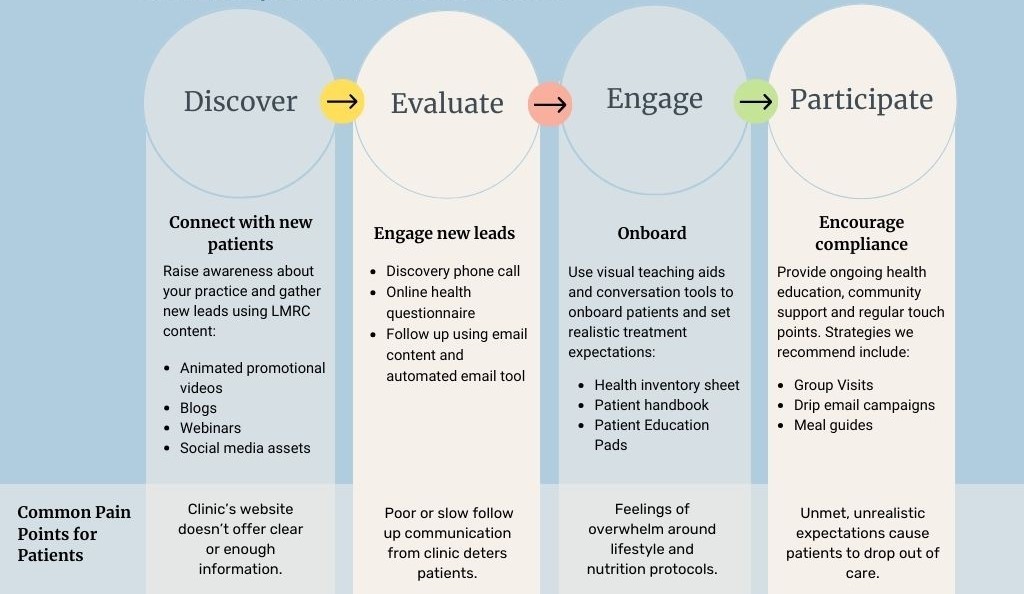Patient experience mapping aims to understand how current or prospective patients behave, with the goal of better serving patients and improving patient-centered care.
Functional, lifestyle or integrative medicine clinics that are building strong businesses learn that curating a positive, intentional patient experience is key to engaging and attracting patients and encouraging retention and compliance.
In this blog post, we will explain why curating a patient journey is important for both business and clinical success and offer suggestions on how to get started.
What is a Patient Journey Map?
The patient experience should be consistent and seamless, while also demonstrating your practice values. Patients should feel comfortable asking questions, and you or your staff should be available and prepared to provide assistance. Finally, patients need to feel comfortable in your physical office space and feel it is a healing environment.
We recommend journey mapping as an exercise to improve or design a positive patient experience.
A patient journey map is a flow chart that visualizes the progression of how patients interact with a practice—from the very first time they hear of the clinic, through or beyond the length of their care plan.
Why Design an Ideal Patient Journey?
The ultimate purpose of developing an ideal patient journey map is to improve patient compliance, retention and satisfaction. Mapping this journey will help identify pain points, and opportunities to improve communication and better support patient-centered care.
Let’s say you are good at attracting new leads, but you’re not converting those contacts into new patients. Or perhaps your patients tend to drop out of care too early. When you map your current patient journey, you may notice there are gaps where communication is sparse or ineffective. You can then make adjustments to address those gaps.
The journey map diagram, once developed, can also serve as a tool to train staff on how to deliver a more ideal patient experience. It can also help identify opportunities to improve your communication and schedule important touchpoints with patients. Curating a patient journey ensures a consistent experience.
Here’s an example of how Lifestyle Matrix Resources Center recommends outlining a patient journey map, including typical content needs for each stage:

*LMRC provides the content listed above to its members, along with consulting services to effectively apply membership materials.
Tips for Designing Your Ideal Patient Journey Map
Develop a list or flowchart describing a typical sequence of touchpoints and milestones, from an initial assessment to laboratory testing and follow-up appointments, through the close of their care (if applicable). An intentionally designed, consistently implemented patient journey is essential for enabling long-term compliance and retention.
Consider the entire process, from start to finish. This includes how patients find you, what happens in between and after visits, or other contacts.
- Know your audience. Consider your ideal patient. What health conditions are they seeking help with? What are their health goals, and what is motivating them to seek support? How eager are they to take control of their own health through lifestyle change? What is their demographic, and how can you best speak to them? Cater your marketing, website messaging and patient communication accordingly.
- Build in multiple touch points, especially when you are working on attracting new patients. This could mean sending regular emailed newsletters to your contact list, or ensuring you have a health questionnaire on your website to engage interested patients.
- Be sure to build in a systemized or automated method of follow-up for new contacts, reminders for appointments, and check in with patients to ask if they have questions about their protocols. Your patient satisfaction, retention and compliance can improve by consistently and reliably communicating with patients.
- Be consistent in your execution. If you commit to following up with prospective patients within 48 hours, be consistent in following through.
Finally, we recommend working with one of our Practice Consultants for guidance. Lifestyle Matrix Resource Center provides practice consulting for its members. Read about other membership benefits here, or take our practice assessment to identify if your practice could benefit from LMRC membership. Interested in learning more? We recommend booking a complimentary info session with our Practice Consultants to dig deeper. In the meantime, read about LMRC's tools for improving patient engagement in this article.

Lauren Ricciardi is a versatile content writer and curator with experience in membership-based organizations.

.png?sfvrsn=b4f251f8_3)

